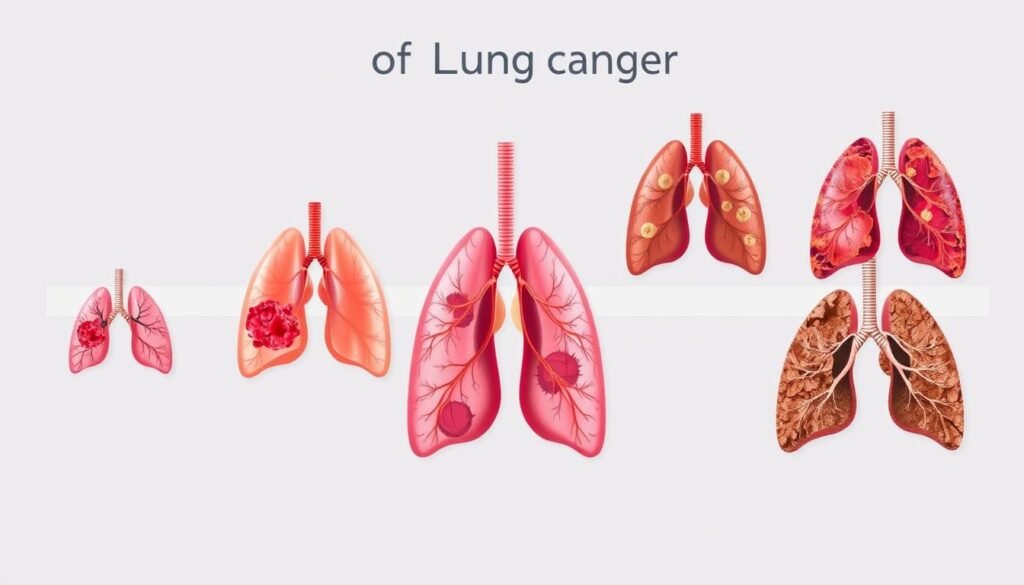Shocking but true, over 80% of people with lung cancer die within five years of finding out they are sick. This shows how urgent it is to know about this terrible illness. In the United States, 79% of those with lung cancer find out when it’s already in stages III or IV. This seriously affects their expected outcome and their quality of life at the end.
This guide wants to explain gently what dying from lung cancer is like. It gives important information about symptoms, stages, and care options for the end of life. Knowing what’s coming can greatly help patients and their families during such a hard time.
Key Takeaways
- Understanding lung cancer’s impact is crucial for patients and families.
- Stage III and IV diagnoses critically affect the course of the disease.
- End-of-life care options can improve quality of life.
- Emotional readiness plays a significant role in the patient experience.
- Awareness of symptoms can help in managing expectations.
- Palliative care aims to provide comfort and minimize suffering.
Understanding Lung Cancer
Lung cancer leads in causing cancer deaths in the United States. Every year, it kills more people than breast, colon, and prostate cancers together. Knowing about this sickness is key for patients and their families. This is because advanced lung cancer usually shows up when it’s already advanced. At this point, the outlook isn’t good. Lung cancer has two main types: small cell (SCLC) and non-small cell (NSCLC). NSCLC makes up about 85% to 90% of all cases.
Most people who get lung cancer are over 65. Smoking is the biggest risk factor, causing about 90% of lung cancers. Even ex-smokers can be at risk, as nearly 60% of those with lung cancer used to smoke. Things like secondhand smoke, pollution, and chemicals also raise the risk.
Often, incurable lung cancer doesn’t show signs at first. When symptoms like coughing, chest pain, and losing weight without trying do appear, it means the cancer has grown. That’s why it’s so important to stay alert and get regular check-ups. Scans and biopsies can catch lung cancer early, when treatment works best.
To learn more about lung cancer’s deadly nature, click here. Seeing a doctor early for symptoms can make a huge difference. Knowing the types and stages of lung cancer helps pick the best treatment. The aim is always to raise awareness and catch it early. This leads to better chances for those who have it.
| Type | Percentage of Cases | Characteristics |
|---|---|---|
| Non-Small Cell Lung Cancer (NSCLC) | 85% – 90% | Includes squamous cell carcinoma, large cell carcinoma, adenocarcinoma. |
| Small Cell Lung Cancer (SCLC) | 10% – 15% | Occurs primarily in heavy smokers, aggressive type. |
Lung Cancer Symptoms
Lung cancer symptoms vary and might not show until it’s advanced. Spotting them early is key for effective treatment. Here are common symptoms folks with lung cancer might face.
Common Symptoms Experienced
People with lung cancer may notice symptoms like:
- Persistent cough, often worsening over time.
- Shortness of breath, making everyday activities more challenging.
- Unexplained weight loss, which can be distressing for patients.
- Fatigue, contributing to a decreased quality of life.
- Coughing up blood, indicating a more severe issue.
Symptoms of Late-Stage Lung Cancer
In late-stage lung cancer, symptoms might get worse and impact overall health. Common symptoms include:
- Severe pain that may require aggressive pain management strategies.
- Pleural effusion, characterized by fluid build-up around the lungs, causing significant discomfort.
- Neurological issues may arise if the cancer spreads to the brain, affecting cognitive function.
- Worsened shortness of breath, making even simple tasks exhausting.
- Increased susceptibility to respiratory infections, such as bronchitis or pneumonia.
Knowing these symptoms helps patients and families get ready for what’s coming. It leads to better management of symptoms and comfort during treatment.
| Symptom | Description | Stage of Cancer |
|---|---|---|
| Chronic Cough | A persistent cough lasting more than eight weeks, common in patients. | Early and Late |
| Shortness of Breath | Difficulty in breathing that progressively worsens. | Early and Late |
| Weight Loss | Unexpected and unexplained weight loss, indicative of the body’s struggle. | Early and Late |
| Pleural Effusion | Fluid accumulation around the lungs, leading to chest pain and breathing problems. | Late |
| Neurological Issues | Can occur if cancer spreads to the brain, impacting mental clarity. | Late |
Stages of Lung Cancer
Lung cancer comes in different stages that guide treatment choices and lung cancer prognosis. It’s crucial to understand these stages to know what a lung cancer diagnosis means. The stage system is different for non-small cell lung cancer (NSCLC) and small cell lung cancer (SCLC). Each stage shows how far the cancer has spread.
Overview of Lung Cancer Stages
The stages for non-small cell lung cancer are:
- Occult Stage: Cancer cells exist but can’t be seen with imaging.
- Stage 0: Abnormal cells are found in the airways.
- Stage 1: This is split into stages 1A and 1B, based on tumor size and spread.
- Stage 2: Tumors are bigger and have reached nearby lymph nodes.
- Stage 3: Cancer has spread more, affecting more lymph nodes than stage 2.
- Stage 4: Tumors may be of any size and have spread far, even to distant organs.
Small cell lung cancer has two main stages: limited and extensive. In the limited stage, cancer is in one lung and might have reached nearby lymph nodes. The extensive stage means the cancer has gone beyond the original spot.
Impact of Stage on Prognosis
Each lung cancer stage impacts lung cancer prognosis and treatment choices differently. For example:
| Stage | Relative 5-Year Survival Rate |
|---|---|
| Localized | 62.8% |
| Regional | 34.8% |
| Distant | 8% |
Survival rates vary significantly by stage, with early detection offering better chances. Stage IV lung cancer, for example, has a much lower survival rate. This highlights the value of catching it early and starting treatment right away. The TNM classification system helps doctors figure out the tumor size, lymph node involvement, and spread of cancer. This is key for working out the prognosis.

What Is It Like to Die of Lung Cancer
Understanding dying from late-stage lung cancer gives insight into what one might go through. It is a time that is deeply meaningful yet hard, showing the physical and emotional sides as death nears.
Experiencing the Dying Process
The dying process varies greatly for everyone, marked by extreme weakness and constant tiredness. Families should know that consciousness may fade, leading to emotional withdrawal or brief moments of clarity. This can confuse but also brings families closer to understanding the end. It’s a time that might involve resolving unfinished matters, giving a sense of closure.
Physical Changes in End Stages
Physical changes become evident as end-stage lung cancer advances. Breathlessness, pain, and loss of appetite are common symptoms. Breathing patterns may change, and alertness can fluctuate. Doctors use medicines like morphine to ease breathing problems.
- Cool skin and cold extremities due to changes in blood circulation
- Increased sleepiness and periods of restlessness
- Difficulty swallowing or a complete cessation of eating and drinking
- Loss of bladder and bowel control
The timeline for these changes varies. Each person’s experience highlights the complex nature of dying, showing emotional and spiritual difficulties. Support from loved ones and healthcare teams is crucial. They provide comfort in these tough times. For more details on what to expect, visit this guide.

End of Life Care
End of life care is crucial for those with terminal illnesses, like advanced lung cancer. It prioritizes comfort and quality of life. Through palliative care, painful symptoms and emotional distress are managed. This allows people to face this tough time with dignity. Good communication between healthcare teams and families is key, ensuring patients’ wishes are honored.
Palliative Care Options
Palliative care enhances the end of life experience. It includes:
- Medications for pain management
- Support for nausea and other gastrointestinal issues
- Strategies to improve breathlessness
- Emotional and psychological support for patients and caregivers
- Spiritual care for existential concerns
Changes in appetite are common in palliative care patients. They might not want to eat or drink, affecting their nutrition. Understanding and improving nutritional support is important. Dietitians can help. Learn about managing taste changes here.
Importance of Comfort Measures
Comfort measures greatly improve life quality during end of life care. These measures include:
- Creating a calming, familiar space for the patient
- Providing respite care for caregivers through hospice
- Offering emotional support to families
Hospice care can give families coping support for up to 13 months. Patients nearing the end may need constant care. They could face extreme weakness and changes in consciousness. Changes in appetite and skin color may also occur.

| Care Aspects | Palliative Care | Comfort Measures |
|---|---|---|
| Pain Management | Focused medications | Holistic approaches |
| Nutritional Support | Guidance from professionals | Encouraging small, favorite foods |
| Emotional Support | Counseling and support groups | Family engagement and presence |
| Environment | Hospice settings | Home care preferences |
Understanding end of life care and the available options helps patients have a dignified, peaceful journey’s end.
Cancer Pain Management
Cancer pain management is key for better life quality in advanced lung cancer patients. Knowing the different pain types and sources helps in finding the right pain relief methods. Patients often feel pain when tumors press on nerves or organs. This requires a plan that includes medicines and mental support.
Managing Pain in Late-Stage Lung Cancer
Managing pain involves opioids, non-opioid medicines, and palliative radiation. Many facing advanced cancer deal with serious pain; 70-90% report this issue. It’s important to keep checking pain levels. This way, care plans can be changed as needed.
Using pain psychology helps manage the emotional sides of pain. It assists in setting achievable goals, improving life quality amidst the pain.
Medication Options for Pain Relief
Opioids like morphine and oxycodone play a big part in cancer pain relief. Since opioids work differently for everyone, treatments need to be custom. Besides opioids, methods like acupuncture and hypnosis could help more when used with standard treatments.
Procedures such as nerve blocks and radiofrequency ablation are promising. They target specific pain sites for better relief and comfort.
It’s vital to keep talking openly with healthcare providers. Good communication ensures the right support for pain management. Knowing how emotional and physical pain connect can improve pain handling.
Lung Cancer Treatments
Lung cancer has many treatments based on your needs. You might get chemotherapy, radiation, targeted therapies, or immunotherapy. Each kind helps manage the disease, especially early on. When it gets to stage IV, the goal changes. Then, it’s about making life better, not curing the disease.
Chemotherapy and Radiation Therapy
Chemotherapy is key for treating lung cancer, especially the small cell type and advanced cases. It aims to kill cancer cells and help you live longer and better. Radiation can be used alone, after chemo, or with it. It uses high-energy beams to target tumors, helping with cure and comfort.
Palliative Treatment Approaches
Palliative care is crucial for those with advanced lung cancer. It focuses on easing symptoms and improving comfort. Patients might get therapies like chemo, immunotherapy, or special radiation to feel better.
The goal is to help people live as well as they can. Teams work to boost life quality for patients and families. Places like Marie Curie Cancer Care offer key support, focusing on easing pain and providing emotional backing.
Lung Cancer Prognosis
Lung cancer prognosis provides insights into what patients can expect. This knowledge is crucial for managing treatment and preparing families.
Understanding Prognosis at End Stage
The prognosis for stage IV lung cancer is challenging. Only about 5 out of 100 people survive longer than five years after diagnosis. This stresses the importance of honest conversations about survivability.
Early detection can lead to better outcomes. Nearly 65% of patients in stage I live five years or more. This shows how crucial early action is.
Factors Influencing Life Expectancy
Several factors can influence how long a lung cancer patient lives, such as:
- Overall health: Healthier people usually have better outcomes and respond well to treatments like surgery and chemotherapy.
- Weight loss: Losing more than 5% of body weight before treatment can lead to a less optimistic outlook.
- Genetic factors: Changes in lung cancer cells can alter how well treatments work.
- Performance status: Patients who can do more generally live longer.
- Gender: Studies show women with lung cancer tend to have a slightly better prognosis than men.
Understanding these factors helps in setting realistic life expectancy expectations. Good communication with healthcare providers is key to informed decision-making.
| Stage | 5-Year Survival Rate |
|---|---|
| Stage I | Approximately 65% |
| Stage II | Approximately 40% |
| Stage III | Approximately 15% |
| Stage IV | Approximately 5% |
Quality of Life Considerations
When facing advanced lung cancer, the quality of life is a major concern for both patients and their families. They may face strong feelings of anxiety, depression, and isolation. It’s important to recognize these emotions. They are natural reactions to losing health and independence.
Emotional and Psychological Impact
The physical symptoms of lung cancer, like fatigue and pain, add to emotional despair. This can affect mental health greatly. Studies show lung cancer patients often feel worse off than healthy people or those with other cancers.
Support Systems and Resources
Having support from family and friends makes a big difference. Talking openly about fears can help ease the mind. Plus, finding support through counseling and groups for lung cancer can be invaluable. It offers a chance to share and learn coping skills, building community and improving life quality in tough times.